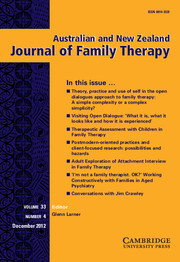Article contents
I'm Not a Bad Mother – Stories of Mothering-on-the-Edge
Published online by Cambridge University Press: 03 August 2012
Abstract
This article is located in the field of custody and day-to-day care, with a focus on experiences of mothering where mothers no longer have everyday care of their children. At the time of writing, tens of thousands of mothers live separately from their children in Aotearoa, New Zealand. However, there is a general perception of rarity associated with non-resident mothers, partly due to their reluctance to speak of loss of custody. In this article, we develop a theoretical discussion around the inside/outside relationships between non-resident mothers and their children that informs therapeutic practice. We argue that mothers who live apart from their children are situated at the edge or periphery of their children's day-to-day lives and experience this as outside the lives of their children. Nevertheless, mothers’ stories speak of qualities of (m)othering that have been born of and nurtured by longstanding and long-term commitment to their children.
Keywords
- Type
- Articles
- Information
- Australian and New Zealand Journal of Family Therapy , Volume 33 , Issue 2 , June 2012 , pp. 142 - 156
- Copyright
- Copyright © The Authors 2012
References
- 2
- Cited by




